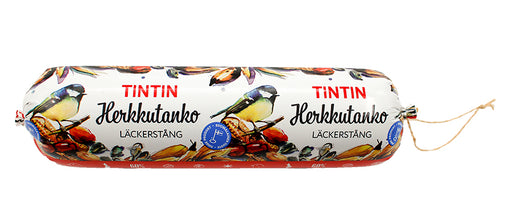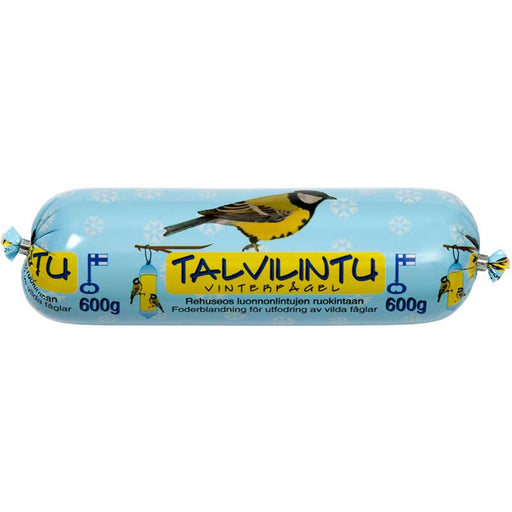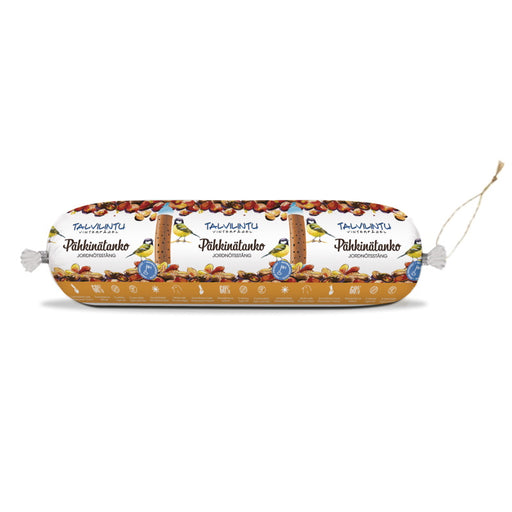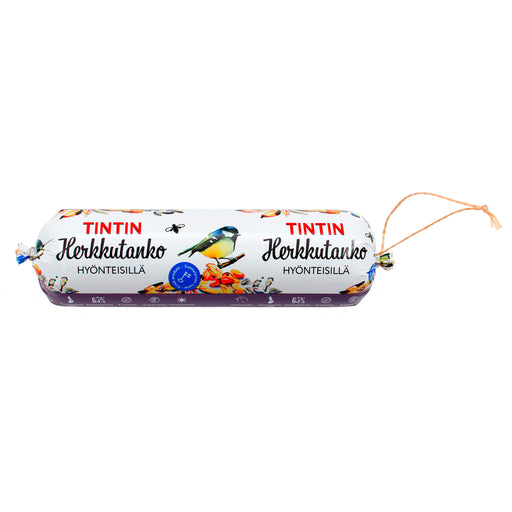Winter feeding helps birds survive Finland’s long and cold winters when food is hard to find in nature. There is also precious little daylight. In those few hours of daylight, birds must find and consume enough calories to survive.
Winter feeding ensures sufficient nutrition for small birds in the coldest cold on the shortest days. In addition, little winged friends will enliven the quiet winter landscape, and you can guarantee beautiful birdsong in the coming spring. Watching birds feed is always a joy. Feedings birds is an opportunity to enjoy the company of wild animals and a good fit for households that cannot have pets.
Winter feeding is useful for birds from autumn until late spring. The feeding in early autumn helps some species gather food for their winter stores. Even those species that do not keep stores will use the tasty seeds to fatten themselves up. The right time to start feeding is when birds start finding less food in nature. Typically, feeding is started when the ground freezes over or is covered by snow. In spring, feeding should be continued until food is again readily available in nature. Spring is a challenging time for birds because of the unpredictable weather, and birds need extra energy for nesting and producing offspring.
Birds learn where they can find food and will often visit familiar feeding sites in autumn to see if food has become available. Migratory birds usually return to the same territory year after year. In March and April, feeding sites will be full of hungry migrants who have depleted their energy reserves during their long journey. In mating season, birds will expend great amounts of energy.
Secluded feeding is safest for small birds
Prepare a safe and quiet feeding site for birds.
The site should be in a sheltered location such as close to a big bush or a dense tree. The feeding site should be located away from any windows so that the birds can avoid flying into them. Good feeding sites allow the birds to see in many directions. Only use feeders, tables, and food items that are safe for birds and cannot trap them. Also make sure that cats cannot stalk the birds at the feeding site.
There are special tables, feeders, and food items made just for birds. For an easy and appetising setting, you can hang up different tallow and treat bars at a suitable feeding site.
Multiple feeding stations make sure that even the lesser birds coming to your yard will have a chance to feed. Please keep the feeding site clean and hygienic to prevent the spread of any diseases during the feeding period. By choosing heat-treated products, you can be sure that the seeds are free of salmonella. A clean feeding site will also be less attractive to unwanted guests such as mice and rats. Choose feeders and food products that prevent the birds from sitting on and soiling the food.
Talvilintu products are extra safe for birds. Their net-free hanging method guarantees that birds will not be ensnared during feeding.
Birds need well-balanced foods
Bird food must have a high energy density to ensure that the bird gains more energy from the food than it spends to feed. A high fat content ensures a high energy density. Bread and other flour-rich products are filling, but rather poor in energy. The food must also be easy for the bird to digest. Fat is very digestible and delivers plenty of energy quickly, whereas seeds are more difficult to break down, for example, requiring more from a bird’s digestive system to extract the energy from the food.
The Talvilintu and Tintin fat-and-seed mixes are specifically designed for the cold and dark Nordic winters where birds need great amounts of energy. By choosing bird foods made in Finland for your feeding site, you can be sure that the food has enough energy and digests well. All Talvilintu and Tintin fat-and-seed mixes are made in Finland and heat-treated – they are clean and safe with absolutely no risk of salmonella.
If you wish for more variety, you can offer peanuts, sunflower seeds, oats, fruits, berries, and lard to birds. Many birds prefer sunflower seeds and will toss out other seeds from the feeder or table. These end up on the ground where yellowhammers and redpolls like to feed, for example. Please note that if your food includes coated seeds, the seed coats left behind by the birds may attract mice, rats, and other unwanted guests to the feeding site. If you are feeding birds with seeds, it is imperative to keep the feeding site clean and free of debris.
The Talvilintu Nut Bar, Talvilintu Tallow-Seed Bar, Tintin Tallow-Seed Mix, and Tintin Delicacy Bar are all excellent choices for additional feeding stations alongside feeders and tables – sure to lure more birds for you to watch. The Talvilintu Spring Treat is the perfect choice for feeding migratory and mating birds. The Spring Treat is rich in protein and minerals, both in high demand for nesting birds.
Even though the weather gets warmer in springtime, birds will spend enormous amounts of energy on building nests and producing offspring. It is a good idea to continue feeding while the spring weather remains unpredictable. Both chicks and mothers will require lots of energy, protein, and minerals until summer.

Bird foods must have a high energy density to ensure that the bird gains more energy from the food than it spends to feed. A high fat content ensures a high energy density.
Bird feed products
-
Tintin Fat Seed Bar
TintinOriginal price 4,90 € - Original price 41,60 €Original price 4,90 € - Original price 41,60 €Original price 4,90 €3,90 € - 33,30 €3,90 € - 33,30 €Current price 3,90 €A big sized fat seed bar for wild birds.
-
Tintin Favourite Fat Seed Bar
TintinOriginal price 4,20 € - Original price 41,60 €Original price4,20 € - 41,60 €4,20 € - 41,60 €Current price 4,20 €New package! A big sized high energy fat seed bar for wild birds.
-
Talvilintu Fat Seed Bar
TalvilintuOriginal price 3,00 € - Original price 32,40 €Original price 3,00 € - Original price 32,40 €Original price 3,00 €2,40 € - 25,90 €2,40 € - 25,90 €Current price 2,40 €Fat content 75 %. The product includes animal fat, oat, soy, sunflower seeds and minced nuts. Over 80 % of raw material is Finnish. Easy to use: T...
View full details -
Talvilintu Nut Bar
TalvilintuOriginal price 3,40 € - Original price 44,20 €Original price3,40 € - 44,20 €3,40 € - 44,20 €Current price 3,40 €Nutritious bird feed with peanuts.
-
Tintin Favourite Fat Seed Bar with Insects
TintinOriginal price 3,40 € - Original price 34,70 €Original price 3,40 € - Original price 34,70 €Original price 3,40 €1,70 € - 17,35 €1,70 € - 17,35 €Current price 1,70 €A big sized high energy fat seed bar for wild birds. Fat 65%. Made in Finland.





